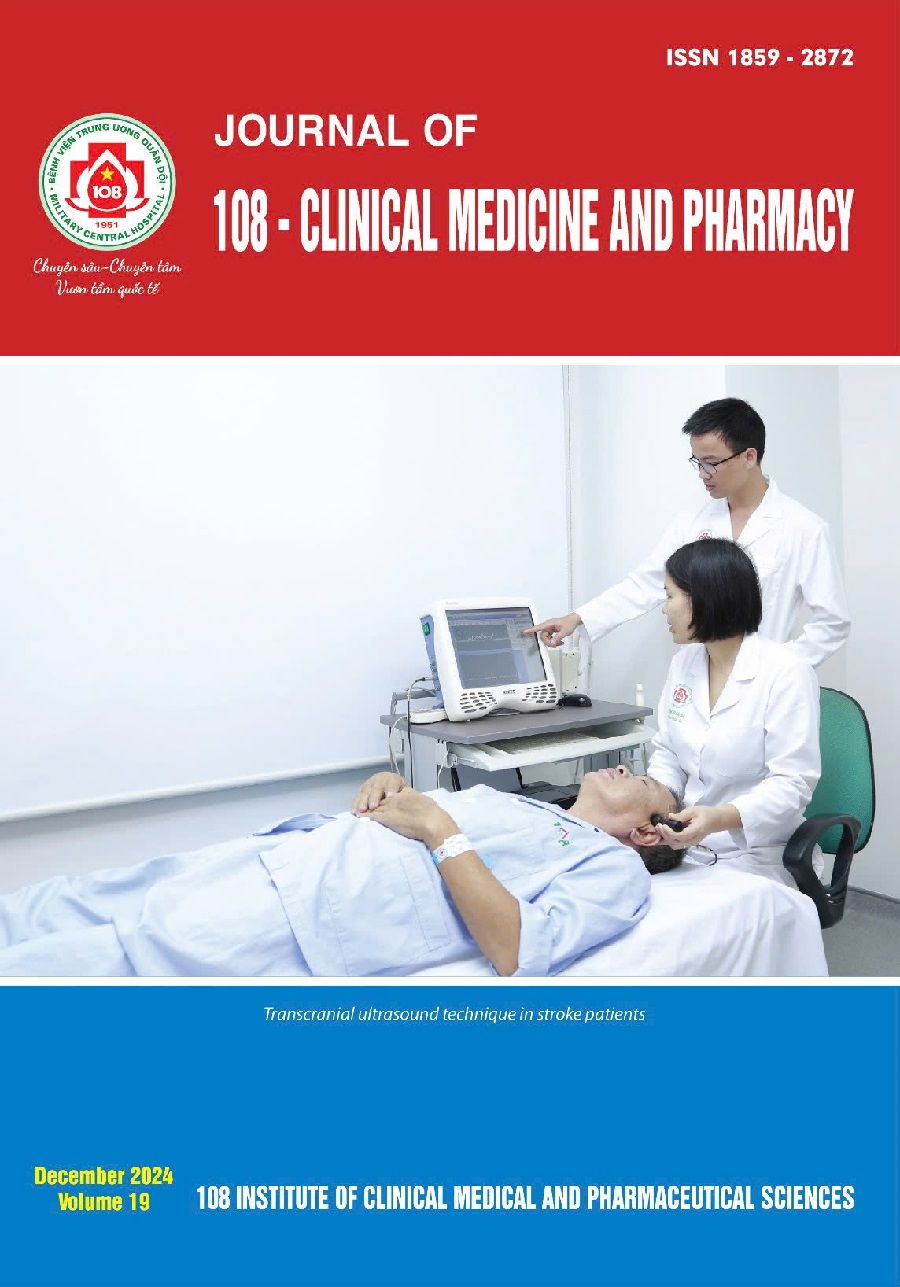Results of analgesia for patients after transurethral resection of the prostate at 108 Military Central Hospital
Main Article Content
Keywords
Tóm tắt
Objective: To evaluate the pain relief treatment for patients after transurethral prostatectomy in general and the effectiveness of patient-controlled analgesia (PCA). Subject and method: Including 124 patients undergoing transurethral resection of benign prostate hyperplasia at 108 Military Central Hospital from June 2023 to June 2024. Study design: Descriptive case series, with subgroups for comparison. Group 1 included 92 postoperative patients who received pain relief with PCA combined with conventional analgesics. Group 2 included 32 patients who received pain relief with conventional analgesics only. Result: Some characteristics of patients in groups 1 and 2: Mean age 72.4 and 72.4, BMI 22.2 and 22.3, prostate mass 64.2 and 69.5 grams, mean postoperative urethral catheterization 4.1 and 4.0 days, no statistically significant difference between the 2 groups (p>0.05). The mean VAS scores of group 1 during the 3 postoperative days were statistically significantly lower than those of group 2. Group 1 had a statistically significant lower pain level than group 2 on the first and second day after surgery. Nausea/vomiting symptoms were recorded on day 1 in groups 1 and 2 at 2.2% and 6.3%, respectively, but the difference was not statistically significant; in addition, no other adverse symptoms related to pain medication appeared in the 2 groups. Conclusion: The combination of PCA and conventional analgesics has better pain relief than regimens using only conventional analgesics. PCA is an effective and safe method in pain relief for patients after transurethral resection of the prostate.
Article Details
Các tài liệu tham khảo
2. Chi J, Wu J, Lou K, Ma J, Wu J, Cui Y (2023) The systematic review and meta-analysis evaluated the efficacy and safety of nefopam for catheter-related bladder discomfort based on randomized controlled trials. Front Pharmacol 14: 1305844. doi:10.3389/fphar.2023.1305844.
3. Li S, Li P, Wang R, Li H (2022) Different interventions for preventing postoperative catheter-related bladder discomfort: A systematic review and meta-analysis. Eur J Clin Pharmacol 78(6): 897-906. doi:10.1007/s00228-021-03251-5.
4. Pastino A, Lakra A (2023) Patient-Controlled Analgesia. [Updated 2023 Jan 29]. In: StatPearls [Internet]. Treasure Island (FL): StatPearls Publishing; 2025 Jan-. Available from: https://www.ncbi.nlm.nih.gov/books/NBK551610.
5. Kose O, Saglam HS, Altun ME, Sonbahar T, Kumsar S, Adsan O (2013) Prilocaine irrigation for pain relief after transurethral resection of the prostate. Journal of endourology/Endourological Society 27(7): 892-895. doi:10.1089/end.2013.0001.
6. Purushothaman J, Kalra S, Dorairajan LN et al (2024) Intravesical bupivacaine in reducing catheter-related bladder discomfort and lower urinary tract symptoms after transurethral surgery: A randomized controlled trial. Indian journal of urology: IJU: Journal of the Urological Society of India 40(3): 161-166. doi:10.4103/iju.iju_431_23.
7. Wang SY, Qiu Q, Shen X (2022) Effect of pudendal nerve block on the prevention of postoperative bladder spasm and catheter-related bladder discomfort in male patients undergoing transurethral holmium laser enucleation of the prostate. Clin Interv Aging 17: 1729-1738. doi:10.2147/CIA.S384612.
8. Charoenpol FN, Khampitak N, Aimnang C et al (2023) Single-dose intravenous nefopam on postoperative catheter-related bladder discomfort in patients undergoing transurethral resection of prostate: a randomized, double-blind placebo-controlled trial. J Anesth 37(1): 72-78. doi:10.1007/s00540-022-03130-y.
9. Sabetian G, Zand F, Asadpour E et al (2017) Evaluation of hyoscine N-butyl bromide efficacy on the prevention of catheter-related bladder discomfort after transurethral resection of prostate: a randomized, double-blind control trial. Int Urol Nephrol 49(11): 1907-1913. doi:10.1007/s11255-017-1663-2.
10. McNicol ED, Ferguson MC, Hudcova J (2015) Patient controlled opioid analgesia versus non-patient controlled opioid analgesia for postoperative pain. Cochrane Database Syst 2015(6):CD003348. doi:10.1002/14651858.CD003348.pub3.
 ISSN: 1859 - 2872
ISSN: 1859 - 2872
